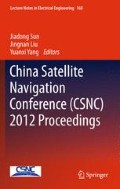Abstract
Based on analyzing the cycle structure of QC-IRA-B codes, QC-IRA-d code was presented in another paper without analysis process in detail and this kind of code is suitable for channel coding scheme of navigation data of COMPASS. This paper analyzes the cycle structure of QC-IRA-B codes based on circulant permutation matrices. The analysis of this paper shows that some special cycle structures result in lots of low-weight code words which worsen the error-correcting performance of QC-IRA-B codes. This paper also shows why QC-IRA-d codes have good error-correcting performance.
Access this chapter
Tax calculation will be finalised at checkout
Purchases are for personal use only
References
Berrou, C., Glavieux, A., & Thitimajshima, P. (1993). Near Shannon limit error-correcting and decoding: Turbo codes. IEEE International Conference on Communications, Geneva, Switzerland, May 1993 (pp. 1064–1070).
Mackay, D. J. C., & Neal, R. M. (1996). Near Shannon-limit performance of low-density parity-check codes. Electronics Letters, 32, 1645–1646.
Jin, H., Khandekar, A., & McEliece, R. (2000). Irregular repeat-accumulate codes. The Second International Conference on Turbo Codes, Brest, France, September 2000.
Roumy, A., & Guemghar, S. (2004). Design methods for irregular repeat–accumulate codes. IEEE Transactions on Information Theory, 50(8), 1711–1727.
Hwang, S. O., Myung, S., Lee, H., Park, S.-I., & Lee, J. Y. (2010). Partial parallel encoder for IRA codes. IEEE Electronics Letters, 46(2), 135–137.
Fossorier, M. (2004). Quasi-cyclic low-density parity-check codes from circulant permutation matrices. IEEE Transactions on Information Theory, 50(8), 1788–1793.
Lu, J., & Moura, M. F. (2005). Partition-and-shift LDPC codes. IEEE Transactions on Magnetics, 41(10), 2977–2979.
Lu, J., & Moura, J. M. F. (2006). Structured LDPC codes for high-density recording: large girth and low error floor. IEEE Transactions on Magnetics, 42(2), 208–213.
Li, Z., Chen, L., & Zeng, L. (2006). Efficient encoding of quasi-cyclic LDPC codes. IEEE Transactions on Communications, 54(1), 71–81.
Wang, Z., & Cui, Z. (2007). A memory efficient partially parallel decoder architecture for quasi-cyclic LDPC codes. IEEE Transactions on VLSI Systems, 15(4), 483–488.
Dai, Y., Chen, N., & Yan, Z. (2008). Memory efficient decoder architectures for quasi-cyclic LDPC codes. IEEE Transactions on Circuits and Systems, 55(9), 3697–3710.
Jiang, N., Peng, K., & Song, J. (2009). High-throughput QC-LDPC decoders. IEEE Transactions on Broadcasting, 55(2), 251–259.
Wu, T.-C., Hu, Y.-W., & Lee, C.-M. (2010). Optimization of memory utilization for partially parallel QC-LDPC decoder. ISITA2010, Taichung, Taiwan October 2010.
Dai, Y., & Yan, Z. (2008). Optimal overlapped message passing decoding of quasi-cyclic LDPC codes. IEEE Transactions on VLSI Systems I: Regular Papers, 16(5), 565–578.
Wang, J., Lei, J., Ni, S., Tang, X., & Ou, G. (2011). QC-IRA-d codes based on circulant permutation matrices. IEEE Communications Letters, 15(11), 1224–1227.
Lei, J., Wang, J., & Gao, Y. (2008). The analysis of cycle structure for a class of quasi-cyclic LDPC codes. IEEE International Conference on Communication Systems, November 2008.
Hu, X. Y., Eleftheriou, E., & Amold D. M. (2001). Progressive edge-growth tanner graphs. IEEE Global Telecommunication Conference, February 2001 (pp. 995–1001).
Author information
Authors and Affiliations
Corresponding author
Editor information
Editors and Affiliations
Rights and permissions
Copyright information
© 2012 Springer-Verlag Berlin Heidelberg
About this paper
Cite this paper
Wang, J., Zhang, K., Tang, X., Ou, G. (2012). Cycle Structure Analysis of QC-IRA-B Codes Based on Circulant Permutation Matrices. In: Sun, J., Liu, J., Yang, Y., Fan, S. (eds) China Satellite Navigation Conference (CSNC) 2012 Proceedings. Lecture Notes in Electrical Engineering, vol 160. Springer, Berlin, Heidelberg. https://doi.org/10.1007/978-3-642-29175-3_3
Download citation
DOI: https://doi.org/10.1007/978-3-642-29175-3_3
Published:
Publisher Name: Springer, Berlin, Heidelberg
Print ISBN: 978-3-642-29174-6
Online ISBN: 978-3-642-29175-3
eBook Packages: EngineeringEngineering (R0)

